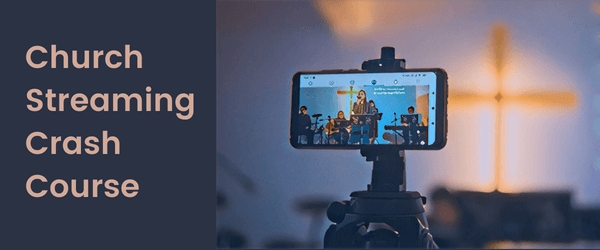In today’s competitive church landscape, neglecting to stream church services could result in losing more of your congregation.
Fortunately, church streaming platforms in 2023 make it easier than ever to reach a wider audience through broadcasting your ministries.
In addition to church live streaming, some streaming platforms also offer video feeds. With these video feeds, you can easily create your own church app for Apple TV, Roku, and Fire TV – no coding required.
In this Church Streaming crash course, you’ll learn how to livestream your church service and everything you need to take your church to the big screen with your own Apple TV, Roku, and Fire TV app.
Let’s get started!
Table of Contents
What Is Church Streaming, Exactly?
Church streaming refers to the practice of broadcasting church services and events (such as sermons) over the Internet. Some churches stream their sermons live in real time, while others record their services for later access by their congregation members through an on-demand video library.
Church streaming platforms help to ensure that the video stream can be accessed through a variety of devices, including smart phones, computers, and smart TVs such as the Apple TV.
Benefits of Live Streaming Church Services
Streaming worship services benefits churches in many ways:
- It allows people who may not be able to attend church in person, such as those who live far away or who have mobility issues, to watch the service in real time and take part in the worship experience.
- Streaming of worship services can also be useful for spreading the Word of God to a wider audience as well as for archival purposes.
- Live streaming services allow churches to engage with their viewers through real-time interactions, such as question and answer sessions and live chat. This enhances the overall experience for the viewer. It also strengthens the connection between the church and its audience.
- Compared to traditional methods of reaching a wider audience, such as building additional churches or hosting large events, live streaming services are often more cost effective.
How to Live Stream Church Services
1. The minimal live streaming setup for small churches
A minimal live streaming setup for small churches typically includes the following components
- Camera: A high-definition video camera, such as a webcam or dedicated video camera, is needed to capture the service.
- Audio: To capture high-quality audio from the service, an external microphone or audio mixer is required.
- Encoder: An encoder is used to encode the video and audio into a format suitable for streaming. Encoders can be software-based or hardware-based.
- Internet connection: In order for the live stream to be delivered without interruption, a stable and fast Internet connection is required.
- Streaming platform: A streaming platform is needed to host and broadcast the live stream, such as YouTube Live, Facebook Live, or a dedicated church streaming service.
- Optional: Additional equipment can be added to improve the quality of the live stream, such as lighting and a teleprompter.
It is important to note that the setup may vary depending on the church’s specific needs and desired livestream quality. However, for small churches looking to begin live streaming their services, this minimal setup should provide a basic solution.
2. Additional Equipement for a Professional Church Streaming Setup
In addition to the minimal setup, a professional church streaming setup may include the following additional equipment
- Professional camera: For more professional, high-quality video production, a high-end video camera with advanced features such as remote control and interchangeable lenses can be used.
- Audio mixer: A professional audio mixer can be used to manage and control audio inputs from multiple sources, such as microphones, instruments, and sound systems.
- Video switcher: A video switcher can be used to switch between multiple cameras to create a seamless live production.
- Lighting: Professional lighting, including LED lights and softboxes, can be used to enhance the live stream’s visual quality.
- Teleprompter: A teleprompter can be used to display the text of a script or presentation in front of the camera, allowing the presenter to read while maintaining eye contact with the audience.
- Streaming encoder: A hardware-based streaming encoder can be used for more reliable and professional streaming.
- Studio monitors: To monitor and control the audio and video quality of the live stream, studio monitors can be used.
Investing in these additional pieces of equipment can greatly improve the overall quality of the live stream. It can also provide a more professional viewing experience for the audience.
Church Streaming Platforms
1. Live streaming provider vs. CDN: what’s the difference
A CDN (Content Delivery Network) and a live stream provider are two different types of technology that serve different purposes in the church streaming process.
A CDN is a network of servers that are strategically located around the world to distribute and cache content, such as video and audio, closer to the end-user. The purpose of a CDN is to improve the speed and reliability of delivering content to a large number of users.
A live stream provider, on the other hand, is a service that provides the infrastructure and tools to encode, transmit, and broadcast live video and audio content over the internet. A live stream provider typically includes features such as encoding software, a broadcast platform, and some distribution options.
2. Church app builders for distribution and reach
A church app is probably the best way to distribute your church videos to mobile and smart TVs. Communities love watching church services on their Apple TV, Roku or Fire TV app.
In summary, a CDN is used to distribute the content to a large audience, while a live stream provider is used to create and transmit the live stream.
If you are not super price sensitive, then a live stream provider who uses a CDN to distribute the live stream is the way to go. Plus one that provides you with a video feed so that you can easily create your church app for Apple TV, Roku and Fire TV.
The Best Live Streaming services for Small Churches in 2023
1. How to find the best live streaming software provider for your church?
Probably for the majority of churches price is an issue. There are advanced live streaming platforms with almost unlimited features. But do you really need and use it? We doubt it.
With a smart combination of Software you can have a perfect church streaming setup that meets all the features:
1.) Use a simple live streaming provider such as ScaleEngine. It’s just 25 USD/month and you get a Roku JSON video feed URL (see point #2). Also good and cheap options are Boxcast or Streamhoster.
2.) Use the Roku JSON feed to build Church TV apps:
- Roku: Roku has a service called Roku Direct Publisher that let’s you create a branded Roku Channel out of your Roku feed – without coding
- Apple TV: Tappla has a similar service than Direct Publisher but for Apple TV. You simply enter your Roku URL and create a native Apple TV app in minutes.
- Fire TV: And Amazon has also a no-code church app solution called Amazon Creator that works similar.
Total price if you go with ScaleEngine and Tappla would be 74 USD month.
2. List of Live Streaming Software providers for Small Churches in 2023
Here is a list of the most popular live streaming platforms for churches in 2023. Each platform has its own strengths and weaknesses, and the choice of platform will depend on the specific needs and budget of the church.
If you want to have a low-budget, feature-rich solution than we recommend the following combo:
ScaleEngine or Streamhoster for live streaming + Tappla for your Church Apple TV app + Direct Publisher for your Roku Channel.
Else, if you have bigger budgets, take a look at one of these live streaming providers:
- Vimeo OTT: Vimeo OTT (Over-the-Top) is a streaming platform that is used by many individuals and organizations for live streaming and video on demand. Vimeo OTT is known for its high-quality video playback, customizable branding, and advanced features like analytics and audience management.
Users generally have positive opinions about Vimeo OTT, citing its user-friendly interface, reliable video playback, and robust set of features. Some users also appreciate the customization options and the ability to use their own domain name for the streaming platform.However, some users have reported that Vimeo OTT can be more expensive compared to other OTT platforms, and that its customer support could be improved. Additionally, some users have reported difficulties integrating Vimeo OTT with other systems or platforms.
- Dacast: DaCast is a live streaming and video hosting platform that is used by individuals and organizations for live streaming and video on demand. DaCast is known for its flexible pricing options, advanced monetization features, and robust set of video hosting and streaming tools.
Based on user reviews and ratings, DaCast is generally well-received by its users. Many users praise the platform for its ease of use, flexible pricing, and advanced monetization options. They also appreciate the platform’s reliability, high-quality video playback, and comprehensive set of features.However, some users have reported that DaCast can be more expensive than other live streaming platforms, and that its customer support could be improved. Additionally, some users have reported difficulties with the platform’s user interface and features.
- UScreen: UScreen is a video-on-demand and live streaming platform that is used by individuals and organizations for streaming video content. UScreen is known for its flexible pricing options, advanced monetization features, and comprehensive set of video hosting and streaming tools.
Based on user reviews and ratings, UScreen is generally well-received by its users. Many users praise the platform for its ease of use, flexible pricing, and advanced monetization options. They also appreciate the platform’s reliability, high-quality video playback, and comprehensive set of features.
However, some users have reported that UScreen can be more expensive than other video hosting and live streaming platforms, and that its customer support could be improved. Additionally, some users have reported difficulties with the platform’s user interface and features.
- Sharefaith: Sharefaith is a digital media and marketing platform that provides a range of tools and resources to support churches and ministries in their outreach efforts. The platform includes a live streaming solution, as well as other features such as website design, graphic design, and media storage.
Based on user reviews and ratings, Sharefaith is generally well-received, with users appreciating its comprehensive suite of tools and resources, as well as its focus on church and ministry outreach. However, some users have noted that the platform may be more expensive and have reported difficulties with customer support and some of its tools and features.
- Boxcast: Boxcast is a live streaming platform that provides a range of tools and resources for streaming live events, including religious and spiritual services. The platform is known for its easy-to-use interface, reliable video delivery, and comprehensive set of features.
Based on user reviews and ratings, Boxcast is generally well-received, with users appreciating its ease of use, reliable video delivery, and comprehensive set of features. However, some users have noted that the platform may be more expensive and have reported difficulties with video quality and some of its video player and embedding features.
- Streamhoster is a live streaming platform that provides a range of tools and resources for live video streaming, including religious and spiritual services. The platform is known for its affordable pricing, reliable video delivery, and easy-to-use interface.
Based on user reviews and ratings, Streamhoster is generally well received, with users appreciating its affordability, reliable video delivery, and ease of use. However, some users have noted that the video quality may not be as high as other platforms, and that the platform’s feature set may be more limited than other platforms.
Summing It Up: What to Do After The Church Streaming Crashcourse
In conclusion, live streaming services are important for churches in today’s world, as they allow churches to reach a wider audience and increase engagement. When choosing a live-streaming service for your church, it’s important to consider factors such as the features offered, the quality of the service, and the cost. Tappla is a new and innovative live-streaming service that provides a wide range of features for churches and is worth considering when choosing the best live-streaming service for your needs
FAQ
1. What cameras do churches use for live streaming?
The type of camera used for live streaming in a church will depend on several factors, such as budget, the size of the sanctuary, the desired video quality, and the overall technical setup. Here are some of the cameras that are commonly used in church live streaming:
- Smartphone cameras: For small churches or those just starting to live stream, a smartphone camera can provide a quick and easy solution for basic live streaming.
- Webcams: Webcams are an affordable and convenient option for small churches or those that don’t have a large budget for live streaming equipment.
- DSLR cameras: DSLR cameras are a popular choice for churches that want to produce high-quality video. They offer manual control over exposure, focus, and other settings, making them a versatile option for live streaming.
- PTZ cameras: PTZ (pan-tilt-zoom) cameras are ideal for larger churches that want to be able to control the camera remotely and easily change the shot. They are typically more expensive than other camera options but provide more professional results.
- Pro-level video cameras: For large churches with a significant budget, professional video cameras are a good choice for live streaming. They offer high-quality video and advanced features like manual control over focus, exposure, and zoom.
Ultimately, the best camera for live streaming in a church will depend on the specific needs and budget of the church. It is important to choose a camera that provides a reliable, high-quality live streaming experience for the audience.
2. Does my church need a streaming license?
Whether or not a church needs a streaming license depends on the type of content being streamed and the laws of the country where the church is located. In general, most countries have copyright laws that protect the rights of musicians, artists, and other creators of copyrighted material.
If a church plans to stream music, videos, or other copyrighted material as part of its live stream, it may need to obtain a license to do so legally. Some churches may be able to use a blanket license from a performing rights organization, such as ASCAP or BMI, to cover the use of copyrighted music in their live streams.
It’s important to note that laws and licensing requirements can vary from country to country, so it’s best to check with a local attorney or a licensing organization for specific guidance on streaming licenses for your church.
In summary, while not all churches will need a streaming license, it’s important to be aware of copyright laws and to ensure that the church has the necessary licenses and permissions for any copyrighted material used in its live streams.




0 Comments